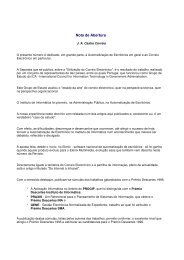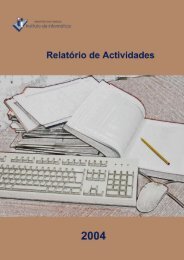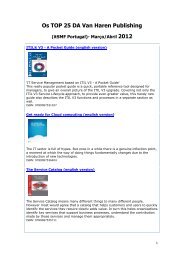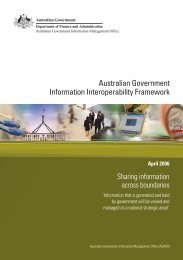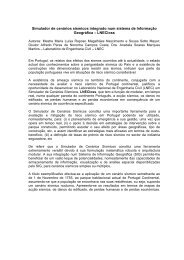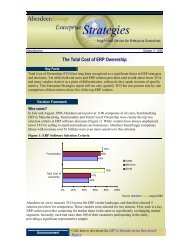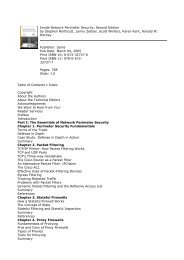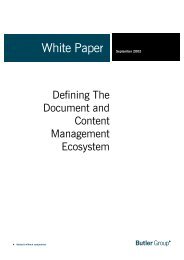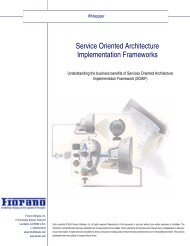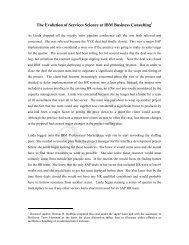OECD Peer Review of E-Government in Denmark - ePractice.eu
OECD Peer Review of E-Government in Denmark - ePractice.eu
OECD Peer Review of E-Government in Denmark - ePractice.eu
You also want an ePaper? Increase the reach of your titles
YUMPU automatically turns print PDFs into web optimized ePapers that Google loves.
m<strong>in</strong>imisation <strong>of</strong> the risk for <strong>in</strong>dividual projects, and creation <strong>of</strong> a more flexible and competitive ICT<br />
market.<br />
The white paper proposed five core architectural pr<strong>in</strong>ciples: 1) <strong>in</strong>teroperability; 2) security; 3)<br />
openness; 4) flexibility; and 5) scalability. To give effect to these it recommended that government<br />
adopt a “service-oriented architecture” (SOA) model based on various <strong>in</strong>ternational standards. The<br />
SOA model treats <strong>in</strong>dividual ICT solutions (developed as either s<strong>in</strong>gle-agency or shared <strong>in</strong>itiatives) as<br />
modularly designed “services” with well-def<strong>in</strong>ed <strong>in</strong>terfaces with each other and to legacy systems.<br />
Interoperability<br />
To implement the architecture, the National Enterprise Architecture Committee was established<br />
under the Co-ord<strong>in</strong>at<strong>in</strong>g Information Committee and charged with develop<strong>in</strong>g and ma<strong>in</strong>ta<strong>in</strong><strong>in</strong>g the<br />
common architecture framework. This work has manifested itself as the Danish e-government<br />
<strong>in</strong>teroperability framework (formerly called the Reference Pr<strong>of</strong>ile), which documents selected<br />
standards, technologies and protocols to give effect to the architectural pr<strong>in</strong>ciples noted above. In June<br />
2005, an updated version (release 1.2.1) <strong>of</strong> the <strong>in</strong>teroperability framework, conta<strong>in</strong><strong>in</strong>g 461 standards,<br />
was launched. Three notable features <strong>of</strong> this release were: 1) the change <strong>of</strong> its name from the<br />
Reference Pr<strong>of</strong>ile to the “OIO Catalogue”; 2) the <strong>in</strong>clusion <strong>of</strong> a decision support tool to aid <strong>in</strong> the<br />
adoption <strong>of</strong> multi-media standards; and 3) <strong>in</strong>clusion <strong>of</strong> the first process standard (on <strong>in</strong>formation<br />
security processes) alongside exist<strong>in</strong>g technical and data standards.<br />
Beyond simply develop<strong>in</strong>g these frameworks, <strong>Denmark</strong> has made sure that they are well<br />
communicated and easily accessible to those who are expected to implement them. In 2004, the ITST<br />
organised a major conference to present and discuss the enterprise architecture with State and local<br />
government, and repeated this successful <strong>in</strong>itiative <strong>in</strong> February 2005.<br />
To make the architecture accessible, the OIO Catalogue and other common data and ICT<br />
frameworks and standards are comb<strong>in</strong>ed to form part <strong>of</strong> the Danish InfoStructurebase, an onl<strong>in</strong>e<br />
knowledge management and collaboration tool that supports exchange and r<strong>eu</strong>se <strong>of</strong> data related to<br />
service delivery, with a focus on enabl<strong>in</strong>g co-operation, bus<strong>in</strong>ess re-eng<strong>in</strong>eer<strong>in</strong>g and alignment <strong>of</strong><br />
services across organisational boundaries. The InfoStructurebase is open for use by both the public<br />
and private sectors, with<strong>in</strong> and outside <strong>Denmark</strong>. There are four ma<strong>in</strong> areas to the InfoStructurebase:<br />
• Infosite: a database <strong>of</strong> <strong>in</strong>formation about standardisation <strong>in</strong>itiatives and communities.<br />
• Repository: a repository <strong>of</strong> <strong>in</strong>ternational standards cover<strong>in</strong>g: 1) bus<strong>in</strong>ess processes; 2) data<br />
model and <strong>in</strong>terface descriptions; 3) complex XML schemas; and 4) XML schema fragments<br />
developed by both public and private organisations.<br />
• Forum: a forum for discussions about XML, Web services and other relevant<br />
service-oriented issues.<br />
• UDDI: a UDDI (Universal Discovery, Description, and Integration) repository conta<strong>in</strong><strong>in</strong>g<br />
<strong>in</strong>formation on XML Web services.<br />
<strong>Denmark</strong>, like many <strong>OECD</strong> countries, is embrac<strong>in</strong>g the use <strong>of</strong> XML (eXtensible Markup<br />
Language) as a standard means <strong>of</strong> manag<strong>in</strong>g <strong>in</strong>formation use across the public sector. In essence, the<br />
InfoStructurebase allows public <strong>in</strong>stitutions to f<strong>in</strong>d out what data exists <strong>in</strong> public databases and how it<br />
can be accessed. This enables improved public adm<strong>in</strong>istration through more effective use and r<strong>eu</strong>se <strong>of</strong><br />
that data, based on use <strong>of</strong> XML and related technologies. The process <strong>of</strong> develop<strong>in</strong>g the various XML<br />
105



